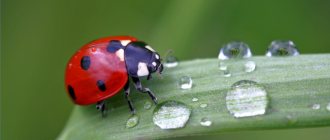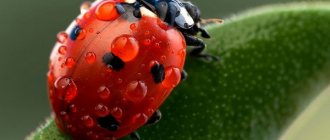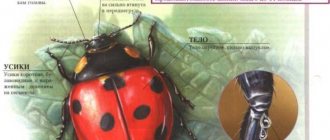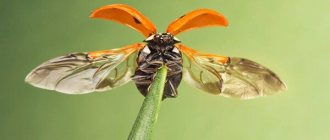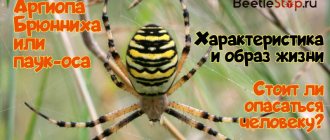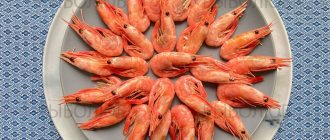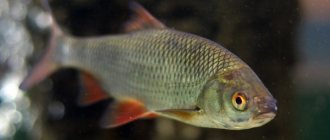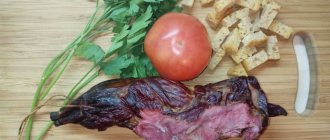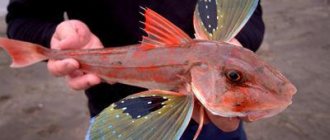- Wild animals
- >>
- Insects
Everyone associates the ladybug There is probably no person who has not held it in the palm of his hand at least once. There are many poems dedicated to this little insect, which kids read every time it fell into their hands. Some consider it a symbol of good luck, others consider it an assistant in the fight against harmful insects in gardens and vegetable gardens - it evokes sympathy among everyone.
Origin of the species and description
Photo: Ladybug
The ladybug is a very common ancient arthropod insect all over the world, a representative of the order Coleoptera and the ladybird family. This insect received its scientific name Coccinellidae due to its scarlet color. The bug lives almost everywhere. It was popularly nicknamed the ladybug because of the poisonous white liquid or “milk” that the insect secretes to scare away predators, and the ladybug because it helped in the fight against aphids and other pests to preserve the harvest, had a gentle disposition, and did not cause any harm to humans. .
Video: Ladybug
In Germany and Switzerland, the tiny insect is called St. Mary's bug, in South America - St. Anthony's ladybug. There were many legends about this little bug; it was said to have the ability to influence the weather.
Interesting fact: Even in ancient times, the Slavs considered the ladybug to be a heavenly creature, a messenger of the sun. That is why she was often called “Sunny”. It was forbidden to drive away the insect, so as not to incur bad luck. A bright bug that flew into a home brought blessings.
There are a huge number of varieties of ladybugs: the entire family has more than four thousand species, which in turn are divided into 7 subfamilies and 360 genera. The ladybug differs from other representatives of the family Coccinellidae in the structure of its legs. In the structure of each of them there are three visible and one hidden segment, so they seem to be three-component.
History of the name
If we consider the Latin name of the insect, in translation it means “scarlet”, which corresponds to the color of the bug. And the popular name appeared quite a long time ago due to sympathy for this insect. In Germany and Switzerland, the creature is called the “Virgin Mary’s bug”; in Slovenia and the Czech Republic, the insect is known as the “sun” (as many are accustomed to calling the ladybug in Russia). This creature also lives in Latin American countries, and they call it “St. Anthony’s bug.”
The origin of the domestic name ladybug is currently unknown. Some researchers believe that the bug received this name due to its ability to destroy aphids. Thus, a simple creature helps preserve huge crop plantations. It becomes clear what ladybugs eat.
Appearance and features
Photo: Ladybug in nature
The size of the ladybird ranges from 3.5 to 10 mm. The bug's head is small and motionless. The eyes are relatively large, the antennae of 8-11 segments are very mobile and flexible. The body of a ladybug consists of a pronotum, a thorax, three pairs of tenacious legs, an abdomen, and wings with elytra. The insect's pronotum is convex, often with spots of various colors and shapes. Bugs fly using the back pair of wings, while the front ones, in the process of evolution, were formed into strong elytra, which now serve as protection for the main pair of soft wings. Not all ladybugs have the usual scarlet color and black dots on their backs.
From all their diversity, the following varieties can be distinguished:
- two-spot - a bug with a body size of up to 5 mm. It has a black pronotum, and the bright red elytra are decorated with two large black spots;
- seven-spot - has a size of 7-8 mm, widespread throughout Europe. On its red back there are two white spots and 7 black ones;
- twelve-spotted - a red or pink bug with an elongated body shape and 12 black spots;
- with thirteen spots - distinguished by an elongated body and a dark brown or red-brown back, the spots can merge with each other;
- fourteen-pointed - a characteristic feature of the elytra is yellow or black;
- seventeen-spotted - the size of the insect is no more than 3.5 mm, it has a bright yellow back with black dots;
- blue - found only in Australia;
- ocellated - characterized by a large body size up to 10 mm. All black dots on the red or yellow back of the insect are framed by light rims;
- pointless - their size does not exceed 4.5 mm, they have a dark brown back color, their body is covered with fine hairs. They are extremely rare in nature.
Not all varieties of ladybug benefit people. The alfalfa beetle is a pest for many agricultural species. crops, it actively eats young shoots, destroys the harvest of beets, cucumbers, and so on. The bug is distinguished by its small size, up to 4 mm, it has a red back strewn with 24 dots.
Where does the ladybug live?
Photo: Ladybug in Russia
The ladybug is found in almost all, even the most remote corners of the globe, with the exception of northern latitudes. The optimal temperature for this bug is not lower than 10 degrees Celsius.
For accommodation they choose:
- forest edges;
- meadows and steppes;
- gardens and vegetable gardens;
- can be found in city parks.
With the onset of cold weather, some ladybugs fly to southern latitudes for wintering. They fly very high, during rain or strong wind they fall to the ground and wait out the bad weather. A large number of beetles die during these flights, especially when they accidentally land or fall into bodies of water from which they cannot get out. Sometimes you can see river banks literally painted red due to the huge number of dead insects.
That part of the ladybugs that do not leave their place of residence for wintering in warm regions gathers in huge scarlet colonies, which can number millions of individuals. They hide in secluded places: under the bark of trees, stones, leaves, and fly into living quarters. They spend the entire winter in a state of torpor and only come to life with the first warmth.
Interesting fact: Ladybugs always hibernate in one place, and then return exactly to the area from which they came. Even young animals find their way to wintering on their own.
Lifestyle
Ladybugs prefer to live “alone”, apart from other representatives of the species.
Only during the mating season do they come together to continue their family line. They also gather together for flights and wintering.
A ladybug can be called a fruit-loving bug, therefore, with the onset of a cold period, all insects living in temperate latitudes gather together and fly away to warm countries.
Among insects there is a sedentary species. They do not fly to countries with hot and dry climates, but gather in one place and winter in huge communities, reaching 400 million adult individuals. If you calculate how much such a “ball” weighs, you can get a figure equal to several tons.
To shelter from unfavorable climatic conditions, the “suns” hide in the ruins of stones and also take cover under fallen leaf blades of shrubs.
Under good conditions and the availability of food, spotted insects can live for 1 year. Under unfavorable conditions, the lifespan of insects does not exceed several months.
What does a ladybug eat?
Photo: Miraculous ladybug
The ladybug is a real predator among insects. Thanks to the structure of its jaw and the functioning of its digestive tract, it is able to hunt other insects and then quickly digest them. There are varieties that choose plant food: pollen, mold, flowers and leaves.
The diet of predatory species includes mainly:
- aphids in huge quantities;
- spider mites;
- caterpillars;
- insect larvae;
- butterfly eggs;
- some do not even disdain the larvae of Colorado beetles.
Ladybugs eat a lot, they are always hungry, especially their larvae. Each individual can easily destroy more than a hundred aphid larvae per day. Having large eyes, insects mainly use only their acute sense of smell in search of food.
The bugs do not hunt their victims, but only slowly, leisurely move through the foliage in search of food, and when they find a colony of aphids or a clutch of eggs of pests, they linger for a long time in this place for a meal until they destroy it completely. That is why the ladybug is a welcome guest on any personal plot, agricultural fields with crops, and in the garden. They are even specially bred at special enterprises and then distributed over cultivated lands with the help of agricultural aviation. Unfortunately, some varieties of these bugs, mainly living in Asia, cause damage to crops.
Now you know what ladybugs eat. Let's see how to breed these beautiful insects.
INTERESTING FACTS, INFORMATION
- A ladybug larva eats about 90 adult insects and 3,000 larvae before reaching maturity.
- In Central Asia, there lives a miniature ladybug - a small black beetle, whose length is only one and a half millimeters.
- All ladybugs have approximately the same shape - their bodies are round, highly convex on top and flat on the bottom.
- There is one species of hymenoptera that can eat ladybug larvae from the inside.
- Cows come in stripes and single colors - not all have dots. They differ in color, for example, a two-spotted ladybug can be red with black dots or vice versa, black with red dots.
Features of character and lifestyle
Photo: Red ladybug
All varieties of ladybugs choose an isolated lifestyle and form groups only for flying to warm regions or wintering in a secluded place. These huge groups can number up to 40 million individuals. You can also notice clusters of bugs during their mating season. All these bugs do not hesitate to feast on the larvae of their relatives, but only in the absence of a sufficient number of aphids and other food. But there are varieties of ladybugs that purposefully destroy their fellow creatures.
Interesting fact: The yellow marbled ladybug was specially bred as an effective biological weapon against agricultural pests, but it was because of it that some varieties of these bugs were in danger of complete extermination, since the marbled ladybug destroyed them in huge quantities along with other insect pests .
These insects are active all day, they slowly crawl from one plant to another in search of food. Given enough food, the lifespan of some individuals can reach two years or even more, but this happens extremely rarely. The main part dies much earlier, before reaching the age of one year, and there are many reasons for this: from lack of nutrition to environmental pollution.
Nutrition
Most ladybugs are predators. Both larvae and adults feed on insects, including:
- aphid;
- caterpillars;
- scale insects;
- spider mites;
- eggs of butterflies and Colorado beetles;
- insect larvae.
Bugs do not hunt in the literal sense of the word. They do not ambush prey or set traps. The ladybug slowly crawls through the plant until it comes across something it can eat.
Representatives of several species eat exclusively plant foods: leaves, flowers and fruits, pollen, mushroom mycelium.
Do they feed in their natural environment in winter?
In winter, insects have no need for food: they either sleep or are in a state of suspended animation. Over the summer, sugar and glycerin manage to accumulate in their tissues. In order not to burst from the temperature drop when cold weather sets in, they have to remove a large amount of fluid from the body.
The ladybugs' task at the moment is to find warm places for wintering. A large number of insects can group together for these purposes in one place. Ladybugs usually prefer dry leaves, bark or window cracks as shelters.
But you should always remember: for such a small predator, a huge human hand poses a serious danger. Do not rush to completely plow the area, or spray the garden with poisons - you will lose your tiny helpers forever.
Social structure and reproduction
Photo: Ladybugs
All ladybugs are solitary. Only during the mating season do males use a specific smell to look for a female to mate with. This usually happens in early spring and soon the female lays up to 400 eggs on the lower surface of the leaves. They are oval in shape and can be yellow or orange. The female chooses a place for laying closer to the aphid colony so that the offspring are provided with food. This is the only manifestation of caring for their offspring. Most often, she dies after this.
After a couple of weeks, the larvae appear. Their body is covered with hairs and has a variegated color; the pattern combines yellow and brown spots. In the first days, the larvae eat the remaining egg shells and unfertilized eggs, then go in search of aphids. The stage lasts from 4 to 7 weeks, after which the formation of a pupa occurs, which then attaches to the edge of the leaflet, where its further transformation occurs.
At the end of it, after 8-10 days, the skin peels off from the pupa like a stocking to the end of the abdomen. A full-fledged individual ladybug appears, which gradually acquires its usual bright color. At first, its elytra are pale in color; by this feature one can easily distinguish an adult from a young one. Young bugs are ready to reproduce at 3 months of life, some only at six months - it all depends on the quality of nutrition and environmental conditions.
From egg to larva
Adults spend the winter in shelters - under stones and fallen leaves, and with the onset of warmth they come out and begin to actively hunt, accumulating strength for reproduction. In spring and early summer, females lay eggs on plants that are affected by aphids, providing future offspring with a food supply. The number of eggs in a clutch depends on the size of the female; especially large individuals lay small portions of up to a thousand eggs, which are attached to plant shoots or the lower part of a leaf.
The Asian ladybug (Harmonia axyridis) lays eggs.
Ladybug eggs are up to 1.2 mm long, have a bright yellow color and an elongated oval shape. Noticing such “beauty” on the leaves of currants and other garden crops, inexperienced summer residents begin to spray chemicals on the plants in horror, not even suspecting that they are destroying the main defenders of the crop.
Asian ladybug (Harmonia axyridis) with a clutch of eggs.
After 1 - 2 weeks, tiny larvae emerge from the eggs, no more than a millimeter long. First, the larva eats the shell of its egg, and then the unfertilized eggs that are in each clutch. Depending on the weather, future ladybugs spend about a month in the larval stage, searching for and eating prey during this time.
Natural enemies of ladybugs
Photo: Ladybug in flight
The ladybug in the wild does not have many enemies due to the specific poisonous white secretion that it secretes. If a bird even once tastes a brightly colored bug, its bitter taste will discourage it from hunting for it for the rest of its life. Many insects quickly die from the ladybug's hemolymph.
The main enemy of ladybugs is dinocampus, a small winged insect that kills adult ladybugs and even its larvae by laying its eggs inside their bodies. As they develop, they feed on the body of their victim, and then the empty shell simply bursts, like in some famous horror films. Dinocampus finds bugs by their protective smell, with which they successfully scare away their other enemies. Parasites are capable of significantly reducing the number of ladybugs in a short period of time.
The active use of various chemicals for cultivating fields and the general depressing state of the environment also have a strong influence on the reduction in the population of these bright bugs. In some countries, there is a trend of replacing chemicals with natural, environmentally friendly methods of pest control. Ladybugs are bred in huge quantities and are even a national export item.
Population and species status
Photo: Ladybug
The population of ladybugs has decreased significantly due to active control of aphids. These little bugs simply have nothing to eat. Due to rapid reproduction and a small number of natural enemies, the population is able to recover in a short period of time if food is available. The status of the species is currently stable. At this time, only some rare varieties of these beetles are under threat of complete extinction, for example, the Australian blue and pointless ones.
Interesting fact: In search of food, a hungry ladybird larva can travel up to 12 meters, which is a huge distance for insects.
Trying to restore the population of beneficial bugs artificially, people sometimes, even with their good intentions, on the contrary, cause significant damage to it. In recent years, millions of individuals, specially bred ladybugs, have been released into their natural habitat, which, due to obvious mutations, changed the nature of their feeding and chose their own relatives as victims. All this caused the death of a huge number of beneficial bugs in all European countries. A thoughtful approach to this problem is needed without undue interference in the natural course of processes in nature.
Red Book
The ladybug has long been listed in the Red Book not only of Russia, but of the whole world. The number of individuals has sharply decreased due to the massive destruction of aphids, which led to the disappearance of the main food source of this insect.
This beetle is one of the most ancient insects on earth. The “law” protects it from extermination, since this insect is extremely useful in agriculture.
Sources
- https://www.poznavayka.org/zoologiya/bozhya-korovka/
- https://animaljournal.ru/article/bojya_korovka
- https://konohovo.ru/stati/chem-pitaetsya-bozhya-korovka-v-prirode.html
- https://protarakanov.ru/bozhya-korovka.html
- https://posevsado.ru/chem-pitaetsja-bozhja-korovka-v-prirode.html
- https://WikiParazit.ru/zhuki/bozhya-korovka-vidy-opisanie.html
- https://aquarium-fish-home.ru/nasekomye/bozhya-korovka-nasekomoe-vidypitanierazmnozheniefotovragiopisanie/.html
- https://zhivotnyeplanety.ru/bozhya-korovka/
- https://2516826.ru/kleshchi/kak-uhazhivat-za-bozhej-korovkoj.html
- https://TaraKlop.ru/zhuki/chto-edyat-bozhi-korovki/
- https://protarakanov.ru/chem-pitayutsya-bozhi-korovki.html
- https://www.m-sokolov.ru/2016/07/07/coccinellidae/
- https://chtoedyat.ru/chto-edyat-bozhi-korovki/
- https://gkd.ru/444094a-chto-est-bojya-korovka-mesto-obitaniya-pitanie-razmnojenie
- https://NatWorld.info/zhivotnye/fakty-o-bozhih-korovkah
- https://bioros.net/nasekomye/bozh-ya-korovka-opisanie-vidy-chem-pitaetsya-interesnye-fakty.html
[collapse]
